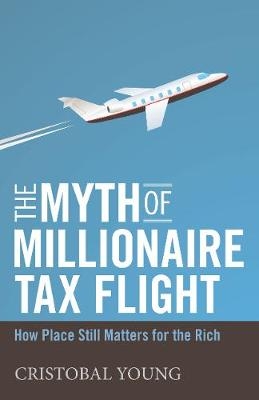
The Myth of Millionaire Tax Flight
Stanford University Press (Verlag)
978-1-5036-0380-6 (ISBN)
In The Myth of Millionaire Tax Flight, Young examines a trove of data on millionaires and billionaires-confidential tax returns, Forbes lists, and census records-and distills down surprising insights. While economic elites have the resources and capacity to flee high-tax places, their actual migration is surprisingly limited. For the rich, ongoing economic potential is tied to the place where they become successful-often where they are powerful insiders-and that success ultimately diminishes both the incentive and desire to migrate.
This important book debunks a powerful idea that has driven fiscal policy for years, and in doing so it clears the way for a new era. Millionaire taxes, Young argues, could give states the funds to pay for infrastructure, education, and other social programs to attract a group of people who are much more mobile-the younger generation.
Cristobal Young is Assistant Professor of Sociology at Stanford University. He studies how sociological dynamics shape the effects of public policies-especially policies meant to reduce inequality. His research has been featured in The Wall Street Journal, The New York Times, and USA Today, and he has contributed pieces to The New York Times Sunday Review and the New York Daily News, among others.
Contents and Abstracts1Millionaire Taxes in a World with Few Borders chapter abstractThis chapter introduces the central questions of the book. In the age of globalization, what is the connection between the rich and the places where they live? Is place a temporary convenience for the rich and powerful-readily switched out when the tides change? Or is place a deep foundation for their success? Are top income earners mobile millionaires searching for low-tax places to live, or are they embedded elites reluctant to move away from the places where they have become highly successful? This chapter also introduces the main empirical data for the book-big administrative data from the tax returns of U.S. millionaire income earners over more than a decade. Finally, the structure and organization of the book is summarized.
2Do the Rich Flee High Taxes? chapter abstractThis chapter explores the empirical evidence for the mobile millionaires versus embedded elites debate. Drawing on the tax returns of U.S. millionaires, this chapter focuses on these questions: To what extent do top income earners migrate away from places with high income taxes? Are millionaires especially concentrated in low-tax states? Do they tend to move from high-tax to low-tax states? What about along the narrow geographic borders of states? In border county regions, do the rich tend to cluster on the low-tax side of the border? This chapter also moves higher up the food chain to look at the location and migration of the Forbes 400 list of richest Americans. Finally, the chapter examines the social demography of the rich: considering how their family and business responsibilities, as well as their age and education levels, can help explain their overall migration patterns.
3Global Billionaires and International Tax Havens chapter abstractThis chapter looks at the global migration of the world's elites, as well as the use of tax havens that allow the rich to move their money abroad. First, the world's billionaires offer an international look at the mobile millionaire thesis. How often do billionaires move to low-tax countries? Are billionaires a transnational capitalist class? Or do they just live in the country where they were born? The analyses here give a clear view into the geographic mobility of the richest people in the world. The second half of the chapter continues the global focus by examining international tax havens. Rather than moving themselves, can the rich achieve tax savings by moving their money into offshore shell companies? The chapter examines how the offshore economy works and what shell companies and tax havens can and cannot do. It also explores which countries are more likely to use offshore accounts.
4Place as a Form of Capital chapter abstractThis chapter explores why place is still important for the rich. The income of the rich depends in part on where they live. Peak performance does not necessarily travel with the individual when the person moves away. Top incomes are sustained not simply through individual brilliance and hard work, but also through collaborative relationships and social networks that depend on being in a shared place. People at the top are deeply embedded insiders who earn economic rewards because their social networks place them close to the action. Top income earners have accumulated much home-field advantage that would be diluted by moving away. It is important to disentangle the idea of travel, which often signifies wealth and status, from the idea of migration, which is often less glamorous-reflecting hardship or entry-level status. The chapter concludes with case studies of open borders in Europe and the United States.
5Millionaires and the Future of Taxation chapter abstractThis chapter revisits the central findings of the book and develops the conceptual and policy implications. How should states set their tax policies? What are the benefits and costs for states that have high income taxes on the rich? The chapter emphasizes that states have little ability to attract the highest income earners, but they can attract a pipeline of future high income earners. These are young professionals-those not yet established in their careers; they are the most mobile individuals, they still have relatively low incomes, and they will not be paying top-bracket tax rates for many years. Progressive taxes are paid by people with late-career success. The revenues pay for education, infrastructure, and services that are most attractive to young, early-career individuals. In this sense, millionaire taxes are an intergenerational transfer.
| Erscheinungsdatum | 08.10.2017 |
|---|---|
| Reihe/Serie | Studies in Social Inequality |
| Verlagsort | Palo Alto |
| Sprache | englisch |
| Maße | 140 x 216 mm |
| Themenwelt | Recht / Steuern ► Steuern / Steuerrecht |
| Sozialwissenschaften ► Soziologie ► Makrosoziologie | |
| Wirtschaft ► Betriebswirtschaft / Management ► Rechnungswesen / Bilanzen | |
| Betriebswirtschaft / Management ► Spezielle Betriebswirtschaftslehre ► Immobilienwirtschaft | |
| Wirtschaft ► Volkswirtschaftslehre ► Wirtschaftspolitik | |
| ISBN-10 | 1-5036-0380-6 / 1503603806 |
| ISBN-13 | 978-1-5036-0380-6 / 9781503603806 |
| Zustand | Neuware |
| Informationen gemäß Produktsicherheitsverordnung (GPSR) | |
| Haben Sie eine Frage zum Produkt? |
aus dem Bereich


